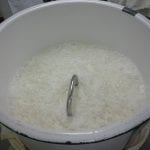A proven formula for great ginjo?
What makes a good ginjo sake? In terms of the aromas and flavors, apparently it is “one part apple to two parts banana.”
 Fukushima Prefecture is currently the sake-brewing region garnering the most attention, at least as far as the industry is concerned. Consumers, of course, may not have the same figures of merit as those that brew and assess sake. There are of course many very famous Fukushima sake amongst consumers as well, but when it comes to technical prowess, most consumers could care less. But the industry pays attention to that stuff, and unquestionably, Fukushima rocks.
Fukushima Prefecture is currently the sake-brewing region garnering the most attention, at least as far as the industry is concerned. Consumers, of course, may not have the same figures of merit as those that brew and assess sake. There are of course many very famous Fukushima sake amongst consumers as well, but when it comes to technical prowess, most consumers could care less. But the industry pays attention to that stuff, and unquestionably, Fukushima rocks.
They so rock, in fact, that they are set to win more gold medals in the National New Sake Tasting Competition than any other prefecture for the seventh year in a row. Furthermore they have reached that pinnacle nine times in the last twelve years. There are a number of reasons for this, including cooperation amongst the brewers themselves, but also support from the local prefectural government. And that support is spearheaded by Mr. Kenji Suzuki of the Technical Support Center of the Fukushima Prefecture High Tech Plaza.
A magazine called Sarai that targets middle-aged men that like to keep up on interesting things (it really is a great publication, my flippancy notwithstanding) published an issue focused on sake a few months ago. It was chock-full of articles on sake and sake brewers, and one of those was a brief article on the basics of sake assessing that included a short interview of Mr. Suzuki. In it, he gave tips on how to taste sake, and learn to taste it better.
He emphasized that the main thing is balance between the aromas and flavors. In other words, what you smell in a sake should give you an inkling of how it will taste. If there is too large of a disconnect, it might not be such a great sake, but when that gossamer thread of consistency runs perceivably through the aromas to the flavors, many people in general tend to find that appealing.
The article also described the concrete characteristics that are found in those sake that regularly do well in blind tastings. And Mr. Suzuki explained that sake that does well in such events tends to have aromas and flavors that are characterized by about twice as much isoamyl acetate as ethyl caproate.
Unappetizing as that may sound, both of those are aromatic compounds created by the yeast during fermentation. Note too that these are not limited to sake; they are found in wine and other  beverages as well, at least to some degree. But they are large part of modern sake aromatic and flavor profiles. And in short, isoamyl acetate smells a lot like banana, and ethyl caproate smells a lot like apple, although it can also come across as strawberry, tropical fruit or even anise.
beverages as well, at least to some degree. But they are large part of modern sake aromatic and flavor profiles. And in short, isoamyl acetate smells a lot like banana, and ethyl caproate smells a lot like apple, although it can also come across as strawberry, tropical fruit or even anise.
So a more memorable and practical way to describe ginjo and daiginjo that often win awards is “one part apple to two parts banana.”
In fact, quite a lot of research goes into these things. I recall reading somewhere that apparently there is no animal (including us, of course) that dislikes the smell of banana. (Don’t go quotin’ me on that, since I do not recall where I read it.) So we can see why that is an integral part of the aromatic profile of popular sake.
Remember that this does not apply to all sake! Ginjo and daiginjo tend to be aroma-driven, or at least, if people are paying for such sake they want aromas to be prominent. Which is fine. But such sake is not the only type of sake worth drinking, and in fact, many sake fans prefer less aromatically ostentatious sake. Pronounced aromas are not obligatory.
Bear in mind always that personal preference always tops any other standard that may be out there. If you like it, then you like it. It doesn’t matter if it is one part apple to two parts banana, two parts apple to one part banana, or one part racoon loins to two parts cigarette butts. De gustibus non est disputandum (about taste there is no dispute).
 However, in blind tastings on the ginjo and daiginjo level, results tend to favor the above-described formula. And, really, the main point here is that these things can be scientifically categorized, and this gives sake brewers a “strike zone” for which to aim, if brewing such sake is their goal.
However, in blind tastings on the ginjo and daiginjo level, results tend to favor the above-described formula. And, really, the main point here is that these things can be scientifically categorized, and this gives sake brewers a “strike zone” for which to aim, if brewing such sake is their goal.
Over time, aromatic profiles in sake – and in particular in the ginjo and daiginjo grades – tend to become more prominent, then less so, with different aromas falling in and out of popularity. But at least for lively styles of sake, “one part apple to two parts banana” seems to have maintained its appeal over the years.




